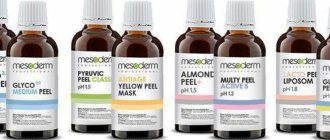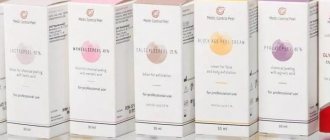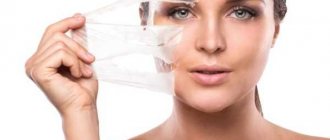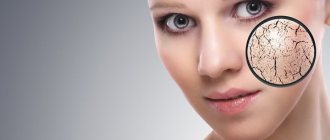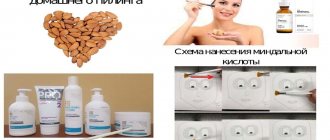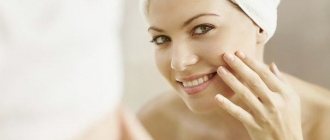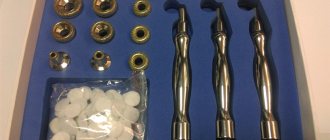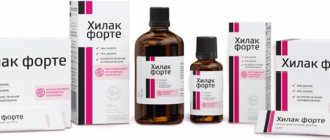Superficial and medium chemical peels
Principles of action and types of chemical peelings - chemical peeling is based on the action of chemical agents (most often acids) and allows you to remove dead skin layers at the same chemical peeling depth, while simultaneously stimulating the regeneration of young cells.
Today, this method of aesthetic medicine still remains one of the most popular. The popularity of chemical peeling is due to its high efficiency, combined with a relatively low cost. Unlike their physical and mechanical counterparts, chemical peels are simple to perform and do not require expensive equipment. If they are performed according to indications and, most importantly, by a cosmetologist, their results are truly impressive! Principles of action and types of chemical peels remove dead skin layers by stimulating the regeneration of young cells.
Depending on the depth of skin damage, all chemical peels are divided into superficial (glycolic peeling, milk peeling, retinoic peeling, pyruvant peeling) and medium. Superficial ones have an effect within the stratum corneum of the skin, middle ones penetrate the skin to the entire depth of the epidermis without damaging the basement membrane, and deep ones affect the basement membrane - partially or completely. It should be noted that deep chemical peeling is a type of surgical operation. And it is almost never used in the practice of a dermatocosmetologist of aesthetic medicine.
Any chemical peel is essentially a chemical burn to the skin. Correct pre-peeling preparation and the use of modern peeling compounds can minimize the risk of complications. Strict control of the depth of damage and creation of optimal conditions for subsequent skin rehabilitation. The Medic Control Peel line includes not only preparations for professional peeling. But also a full range of additional products for pre-peeling preparation and home skin care during the rehabilitation period. And also to maintain treatment results. With such a reliable arsenal at your disposal, you can perform chemical peels in summer and winter.
Indications for use:
- skin aging (wrinkles, decreased turgor, sagging, microrelief disturbances);
- hyperpigmentation of various etiologies;
- problematic skin (acne, rosacea, seborrheic and actinic keratomas, ichthyosis, xeroderma);
- post-acne scars and other etiologies.
Chemical peeling procedure
Any chemical peel involves three stages:
- Pre-peeling preparation;
- Peeling procedure;
- Post-peeling rehabilitation.
Pre-peeling preparation is a very important stage that determines the depth and controllability of the peeling and its effectiveness. It is carried out at home and ensures equalization of the thickness of the stratum corneum, stabilization or inhibition of melanogenesis, and also stimulates skin regeneration (especially aging skin).
A number of techniques have been developed for chemical peeling, each of which has its own characteristics. The peeling composition can be applied to the skin using a brush, gauze pads, cotton pads or cotton swabs. The time of its exposure is determined by objective factors (erythema, swelling/pastyness, frost effect). So and the patient’s subjective sensations (pain, burning). A clear knowledge of the peeling protocol helps to complete the procedure quickly and confidently.
The goal of post-peeling rehabilitation is to level the patient’s subjective discomfort and prevent side effects and complications. Anti-inflammatory and antioxidant therapy, stimulation of regenerative processes and protection of the skin from adverse exogenous factors.
The Medic Control Peel line contains a wide range of special products that meet all of the above requirements.
Chemical peeling is an effective method for correcting involutional changes in the skin and atrophic scars. Milk peeling is indispensable for skin whitening in order to improve its texture. Knowledge of the peculiarities of the interaction of a chemical agent with the patient’s skin and methods for determining the depth of penetration of the peeling composition allows one to achieve excellent results and minimize the risk of complications. Another advantage of the technique is the ease of its execution by a cosmetologist.
Which peeling to choose - the opinion of a cosmetologist
Peeling
(from English to peel in translation means - to remove the peel, to clean) - one of the methods of removing the top layer of skin, which helps to renew the underlying layers.
Depending on the depth of impact, peelings are divided into superficial, medium and deep. There are several types of peeling: chemical, laser, mechanical, plasma. The most affordable and effective is chemical peeling. α - hydroxy acids (glycolic, lactic, tartaric, citric, etc.) and β - hydroxy acids (salicylic, etc.) are most often used as a chemical agent in peelings.
These acids have the following effects: exfoliating effect; influence on the barrier function of the stratum corneum, which manifests itself in strengthening this function by stimulating the synthesis of ceramides; moisturizing effect, which is associated with the removal and renewal of the epidermis, which leads to an increase in natural moisturizing factor (NMF); anti-inflammatory and antioxidant effect, which is carried out through influencing inflammatory mediators and increasing local immunity; enhancing the synthesis of collagen and glycosaminoglycans by stimulating the function of fibroblasts, which contributes to the thickening and compaction of the dermis.
Common types of peeling
Glycolic peeling.
The main ingredient of a glycolic peel is glycolic acid. Glycolic acid has a small molecule, so it easily penetrates the epidermal barrier and has the most pronounced effect. When choosing this type of peeling, such indicators as the pH concentration of the solution are important. Exfoliating activity, changes in the dermis, stimulation of collagen and glycosaminoglycan synthesis depend on these indicators. Using this type of peeling we get the following effects: exfoliation, anti-inflammatory, antibacterial, comedolytic effects, skin texture and color improve, pores narrow and acne scars are smoothed out. However, rapid and uneven penetration may be accompanied by the development of irritation and a burning sensation.
Salicylic peeling.
Salicylic acid is often used as an auxiliary transport system. However, salicylic acid itself can be used as an independent ingredient. It is effective in the fight against acne, prevention of inflammatory elements and has a keratolytic effect in the treatment of dermatoses accompanied by hyperkeratinization (seborrheic dermatitis, psoriasis, ichthyosis, atopic dermatitis). It has the following effects: evens out the relief; anti-inflammatory effect; comedolytic; antibacterial; exfoliating. In addition, salicylic acid softens dry, rough and flaky skin.
Almond peeling.
Mandelic acid has a larger particle than glycolic acid, therefore it penetrates the skin more slowly and evenly, produces all the effects characteristic of glycolic acid, but does not irritate the skin and is ideal for those with sensitive skin. And its antimicrobial activity allows it to be used for more severe forms of acne and hyperpigmentation. It is characterized by the following effects: anti-inflammatory; antibacterial; improves the relief of the skin; depigmenting; reduction in the thickness of the stratum corneum.
Retinoic peeling or yellow.
The active ingredient is retinol. Stimulates the growth and proliferation of basal kerotinocytes and fibroblasts, accelerates cellular renewal of the epidermis and stimulates collagen formation. Due to the inclusion of whitening components, it has a depigmenting effect. Indications for yellow peeling: epidermal melasma (pigmentation); pigmented superficial moles; superficial wrinkles; seborrhea; consequences of acne. During the post-peeling period, severe peeling is characteristic, and manifestations of aseptic inflammation are possible. Contraindicated during pregnancy, lactation, and liver dysfunction.
TCA peeling.
The active principle is trichloroacetic acid. It is used for superficial and medium peeling, accompanied by a pronounced burning sensation and painful procedure. In the post-peeling period, large-plate peeling and hyperemia are noted. Contraindicated during pregnancy and lactation. Effects: stimulating effect on fibroblasts and stimulation of neocollagenogenesis; pronounced leveling effect; comedolytic effect; reducing the depth of wrinkles, the effect of “shrinking” the skin. However, this peeling must be approached very responsibly so that complications do not arise.
Contraindications typical for any peeling
- Warts in the peeling area.
- Herpes in the active phase.
- Photos and solar dermatitis.
- Radiation therapy in connection with cancer.
- Pregnancy and lactation.
- Taking Roaccutane.
- Insolation in less than 2 days.
- Increased sensitivity to peeling components.
- Exacerbation of chronic skin diseases or acute dermatological disease.
- Decompensation of any somatic disease.
- Acute condition.
Which peeling to choose is best decided after consultation with a cosmetologist, who will also advise the frequency and duration of the course of peelings. The severity of the expected effect and the solution of the assigned tasks will depend on this. Best time for peeling
– this is autumn, winter and early spring.
Main tasks of post-peeling care
- Ensuring skin protection from UV radiation (cream with adequate SPF factor).
- Reduction of post-peeling skin reaction.
- Accelerate healing.
- Preventing complications.
For home post-peeling care, adequate and necessary cosmetic products should be selected, aimed at providing comfortable subjective sensations, preserving moisture in the skin, preventing complications and creating conditions for restoring the dermal layer.
In conclusion, I would like to note that peelings are extremely effective and safe in the hands of a specialist.
Make an appointment with specialists by calling a single call center:
+7(495)636-29-46 (metro stations “Schukinskaya” and “Street 1905 Goda”). You can also make an appointment with a doctor on our website, we will call you back!
Types of Chemical Peels
The effect of chemical peeling depends on the depth of skin damage. With increasing depth, the effectiveness of the procedure increases, but at the same time the frequency of possible complications, the duration and complexity of the rehabilitation period increases.
The choice of chemical peel depends on:
- skin condition;
- features of healing of the wound surface;
- areas of expected impact;
- the type of chemical agent included in its composition, its concentration and pH;
- forms of applied peeling composition (gel, lotion, cream, etc.);
- technique and number of applications;
- quality of patient skin preparation.
Based on an assessment of the nature and extent of age-related and pathological changes, taking into account skin type. Classification of signs of photoaging and other objective data. The specialist selects the optimal peeling composition and the depth of its effect, stimulating the regeneration of young cells.
Peeling in summer
✹❀
There is still an opinion that chemical peelings are impossible during periods of high solar activity. Indeed, in some cases it is undesirable to perform peeling in the summer. However, if you choose the right chemical agents and home care products. Then, by performing summer peeling, cosmetologists can successfully solve a number of aesthetic problems in the summer.
Criteria for choosing the type of chemical peeling:
- indications and planned depth of skin damage;
- mechanism of action of the peeling composition;
- contraindications for peeling;
- the patient’s lifestyle (bad habits, social status);
- presence of concomitant diseases;
- the patient's real wishes;
- patient requirements for the terms and conditions of the post-peeling period.
Glycolic peeling
✹❀❄
remove dead skin layers by stimulating the regeneration of young cells aesthetic medicine by a cosmetologist
Glycolic peeling is the most common chemical superficial peeling based on alpha hydroxy acids. Glycolic acid has the most active molecule of all AHA acids, due to which preparations based on it have a pronounced exfoliating, stimulating and antioxidant effect. Peeling with glycolic acid is used to solve a wide range of aesthetic problems: age-related manifestations, hyperpigmentation, skin texture disorders, acne and post-acne scars. The concentration of glycolic acid in AHA peels varies from 30% to 70%, but pH plays an equally important role here. The most effective glycolic peels are characterized by a pH value below 2.0, which implies the mandatory use of a neutralizing composition in the procedure. In addition to glycolic peels based on pure glycolic acid, there are combined glycolic peels based on drugs that include acids such as phytic, kojic, lactic, and salicylic.
Thanks to various combinations of ingredients in peeling products, a specialist has the opportunity to work on a particular problem, taking into account the individual characteristics of the patient as much as possible. It should be noted that all glycolic peels based on alpha hydroxy acids are highly effective, easy to perform and have a short rehabilitation period. The effect of glycolic peeling has been well studied and can be accurately predicted. This makes glycolic peeling extremely popular among specialists. So it is among clients of cosmetology clinics and cosmetologist doctors. Principles of action and types of chemical peels remove dead skin layers by stimulating the regeneration of young cells.
“Acid” sounds scary, but peelings are completely safe
The following acid peels are used in cosmetology:
- Superficial
– affecting the topmost layer of skin. To carry them out, light organic alpha or beta hydroxy acids are used, which include fruit, lactic, and salicylic acids. Such procedures are usually carried out in a course, after which the skin is freed from acne, clogged pores, small scars, and its color improves. - Medium
– exfoliating skin structures to the middle layer. To carry them out, stronger organic acids are used, for example, acetic acid. After the procedure, the affected area will recover for some time, so it is better to do this peeling while on vacation. Acid removes deep scars, severe acne, and blackheads. The skin after recovery looks even better than before visiting the cosmetologist. - Deep
- affects deep skin layers with aggressive acids. They are rarely used because they are quite traumatic. Modern cosmetology offers many more gentle, but no less effective procedures.
Milk peeling
✹❀❄
Other popular peeling preparations are formulations based on lactic acid. They are characterized by high penetrating ability, which allows their use in patients with severe hyperkeratosis caused by both unfavorable exogenous factors and skin aging. Due to the fact that lactic acid is a component of the natural moisturizing factor of the epidermis. Milk peeling interacts very delicately with the skin and maintains a high level of moisture. Recommended for the correction of cosmetic defects, dry and aging skin, aesthetic medicine.
❄
Retinoic peels belonging to the superficial category have gained particular popularity recently. Retinoic peels are also known as “yellow peels” or “weekend peels” (due to the short recovery period). The mechanism of action of retinoic peels is fundamentally different from the mechanism of action of other peeling agents. The retinoids included in the “yellow peeling” do not damage the skin, do not destroy living cells, and do not coagulate proteins. They interact with specific nuclear receptors of cells. Principles of action and types of chemical peels remove dead skin layers by stimulating the regeneration of young cells.
These receptors have been found in basal keratinocytes, melanocytes and fibroblasts. Thus, as a result of the effect of retinoic peels on the epidermis, the level of mitotic activity of basal keratinocytes increases, the processes of differentiation and keratinization, as well as melanogenesis are normalized, the synthesis of epidermal lipids and components of the intercellular matrix of the dermis is activated and stimulated, and the number of atypical cells is reduced. As a result, skin aging slows down, its texture improves, its relief is evened out, and a pronounced rejuvenating and brightening effect is achieved. In addition, yellow peel retinoids have a powerful antioxidant effect. Histological studies have shown that the stimulating effect of retinoic peels on the cellular structures of the skin persists for 4 months after the last application of retinoids. Other important reasons for the demand for retinoic peels are their atraumatic nature and high safety of use, a short post-peeling period and an extremely low rate of complications. Therefore, retinoic peeling can be carried out in the summer.
Almond peeling
✹❀❄
Superficial almond peeling is in constant demand among clients of beauty salons. This is due to its many benefits. Almond peeling has a moisturizing, stimulating and antioxidant effect and is ideal for combating the initial signs of skin aging. Professional almond peeling Medic Control Peel has an additional antimicrobial effect, therefore it is often used to treat problem skin with signs of acne. The mandelic acid molecule is quite large, which determines the gentle effect of the peeling composition on the skin and almost completely eliminates the risk of developing post-peeling hyperpigmentation. Delicate almond peeling is recommended for year-round use for patients with skin of any type. Including dark skin by stimulating the regeneration of young cells of aesthetic medicine by a cosmetologist.
What time of year can you peel?
There is a misconception that it is advisable to do peeling in winter. In fact, the procedure is carried out at any time of the year. For example, it will help in the spring, when after winter the face looks tired and its color leaves much to be desired.
When carrying out the procedure in spring and summer, you need to protect your skin with sunscreen. It is undesirable to stay in the sun for a long time, as this can lead to the appearance of age spots. Caution should be observed for about a week until the new fresh skin gets stronger and can protect itself from the sun's rays.
Salicylic peeling
✹❀❄
Salicylic acid was first isolated from willow bark in the 19th century. Having a pronounced keratolytic effect and high penetrating ability, this beta-hydroxy acid causes peeling of the epidermis. At the mouth of the hair follicle, thereby preventing the formation of comedones. Salicylic acid has a powerful anti-inflammatory and antiseptic effect, reduces the activity of the sebaceous glands. But it does not penetrate into the deep layers of the skin and causes virtually no side effects. Peels based on pure salicylic acid are recommended for patients with thick and liquid seborrhea. Acne, initial and moderate signs of age-related skin changes, photoaging, hyperpigmentation, wrinkles, skin microrelief disorders. They are also used to stimulate exfoliation in ichthyosis and psoriasis. Salicylic acid is included in many peeling preparations. And thanks to its excellent ability to “loose” the stratum corneum of the skin. Salicylic peels are often used in protocols for other chemical peels (for example, retinoic). To improve their penetration and obtain a more pronounced result of aesthetic medicine by a cosmetologist.
Beauty guide: chemical peels - who are they and who needs them?
Chemical peeling is a procedure that is loved by both doctors and patients. What types of peelings are there and do you really need them? We have compiled a detailed guide for you.
Chemical peeling is a controlled damage to the skin, in response to which regeneration processes are launched. The idea is not new. In Ancient Egypt, sour cream rich in lactic acid was applied to the face. French women rubbed their skin with old wine containing tartaric acid. Nowadays, chemical peeling is one of the most popular procedures. According to research by the ISAPS Aesthetic Society in 2018, peeling was among the top 5 most popular procedures in the United States (after Botox and hyaluronic acid injections).
This popularity is facilitated by the low cost of the procedure, because it requires very little: an acid solution, sponges, sponges, brushes, a timer and a little time.
The second (and main) reason is a noticeable cosmetic effect. The skin becomes more even, smooth, wrinkles are reduced, pigmentation and acne spots are lightened, comedones are removed, and pores are reduced. The possibilities of peeling are not limited to just the aesthetic effect. The method is used in the treatment of acne, rosacea and other diseases.
Who needs it and when to start?
The ability to regenerate is the most important property of the skin, without which it could not protect the body from the external environment. In addition to regeneration associated with external damage, renewal processes are ongoing. “If the skin were not renewed, but only grew larger all the time, we would have long ago become like armadillos,” jokes Ekaterina Vladimirovna Miladinova , cosmetologist at the Petrovka Beauty clinic.
However, the mechanism of renewal of the stratum corneum of the skin slows down over time. There are many reasons. On the one hand, this process is inherent in our genes, on the other hand, it is influenced by age and lifestyle - stress, lack of sleep, poor diet, smoking.
Ekaterina Vladimirovna says: “In cosmetology there is a conventional scale of must-haves in care for different ages. At 20 years old, healthy skin has enough sun protection and antioxidants. At 30, moisturizing and exfoliation are added to these two points. At 40, you will additionally need peptides and retinoids. It turns out that by about 30 – 30+, the processes of natural cell exfoliation begin to slow down, and they should begin to be helped.”
Types of Chemical Peels
Peels are usually classified according to the depth of penetration into the skin:
- very superficial - on the very surface of the stratum corneum (exfoliation);
- superficial - acts in the stratum corneum of the epidermis and reaches the papillary layer;
- median - acts in the papillary layer;
- deep - reaches the middle of the reticular layer of the dermis.
Chemical peels are performed with acids. Depending on the type, concentration and pH, some can penetrate deeper, while others work only on the surface. For example, glycolic acid in a concentration of up to 3% is used to treat dermatoses, from 10 to 15% for superficial peels, and more than 25% for superficial-medium and median peels.
pH is an indicator of acidity: the lower it is, the deeper and faster the peel penetrates the skin. It is based on pH that products are divided into home and professional. So, for example, a glycolic peel with a concentration of 30% for professional use will have a pH of 1.8, and for home use - 3 or more. Therefore, if you see a home remedy with a high acid content, most likely its pH will be so high that you cannot harm yourself with it.
The greater the depth of the peeling, the stronger the effect, but also the higher the risk of complications. The rehabilitation period also increases. If regeneration after peeling is successful, the skin will look smoother, firmer, denser and younger. However, after too much damage, scars, hyperpigmentation, redness, or infectious complications may occur.
Home peeling
All kinds of masks, peeling pads (pads soaked in a composition with acid), scrubs combining polishing particles and acids, serums, tonics with acids - all these products act in the very top layers of the skin. They are able to exfoliate 1-2 layers of keratinized cells (out of 12-14).
Cosmetologists recommend using home peelings 1-2 times a week - this will be enough to simply maintain good skin condition. If you want some larger, qualitative changes or need to solve a problem like pigmentation or acne, then you should go to a cosmetologist.
Superficial peeling
A simple and easy procedure performed in the clinic. It is usually easily tolerated and has a good clinical effect. Suitable for, on the one hand, introducing the patient to acids, and on the other hand, so that the doctor gets to know the patient’s skin better and can predict the reaction to acids.
Ekaterina Vladimirovna : “If an unfamiliar patient comes to me, I try to play it safe as much as possible - I suggest doing almond peeling, it is one of the softest. And I start the procedure itself with a light acid wash - so that I can immediately notice if the patient experiences irritation.”
The main thing that superficial peeling does is exfoliate dead particles. It also gives cells a signal to renew - a sharp decrease in the thickness of the stratum corneum is stress for the skin, which causes increased lipid synthesis. Depending on the concentration, pH and type of acid, peelings work at different depths, but still remain within the stratum corneum.
With the help of superficial peels, you can even out texture and tone, lighten pigmentation, reduce fine wrinkles, clean and tighten pores, and prepare the skin for more serious cosmetic effects (for example, deeper peels).
Process: The entire procedure takes less than an hour. The face is cleansed and a peeling composition is applied. Then, depending on the acid, they either wash it off or send the patient home to wash off the composition after a few hours (yellow peeling). The procedure itself is comfortable - you may feel a slight burning or tingling sensation, which quickly passes.
Rehabilitation is fast: 1-3-5 days. Superficial peels do not provide strict rehabilitation - the skin after them may peel off, severely or barely noticeably (depending on the acid and the characteristics of the body). That’s why it’s also called a weekend procedure: if done in the middle of the week, then the peak of peeling will occur just on the weekend, and by Monday the face will return to its proper form.
What else you need to know before you go to a cosmetologist
One procedure is most likely not enough to see the result - you will need a course of 5-7 with a break of a week and a half.
Immediately after peeling, the skin should be allowed to work on its own - the renewal process has just started in it, there is no need to help it. To do this, you will have to give up thick creams for a couple of days.
Medium peeling
The purpose of medium peeling is to intensively traumatize the skin. It serves as an impetus for active cell regeneration, synthesis of collagen, elastin, and hyaluronic acid in tissues. As a result of the course of procedures, the oval is tightened, wrinkles and post-acne scars are reduced, and hyperpigmentation goes away.
For medium peeling, acids are used in higher concentrations than for superficial peeling. For example, glycolic 70%, trichloroacetic 35-50%.
Mechanism: acid molecules are smaller, they penetrate deeper into the skin and work not only on the surface layer, but also at the dermis level - with living cells.
Process: may be painful, the doctor may suggest taking painkillers.
Rehabilitation is not quick: for about 5-10 days the skin will peel off severely, as if you were sunburned. In the first days after the procedure, there may be swelling and redness.
What else you need to know
- Going to a cosmetologist and doing a medium peel right away will most likely not work. The procedure requires skin preparation: superficial peeling is done 4-6 weeks in advance, then products with acids are introduced into home care.
- You should never comb the skin after the procedure or pick out peelings due to the risk of post-traumatic pigmentation.
- The most common complication is the development of hyperpigmentation in those who do not use high-protection sunscreens after the procedure.
Deep peelings
Deep peelings are almost never done now. During the procedure, almost all layers of the dermis are removed, leaving only small islands of tissue. This is practically an operation performed by plastic surgeons under local anesthesia. Deep peelings are carried out with TCA or phenol-based compounds.
It is impossible to predict how the skin will recover after such damage. The regeneration process is very painful and long - up to 6 months, there is a risk of post-inflammatory pigmentation, problems with blood vessels and even skin tone. In fact, the body grows new skin.
However, there is still a demand for the procedure. If healing is successful, even deep wrinkles and age spots will disappear, and the skin will noticeably tighten. The effect of such peeling lasts 10-15 years.
Ekaterina Vladimirovna : “With the advent of lasers, many clinics abandoned deep peelings. Because in order to work in the deep layers of the skin with peeling, you need to damage the upper layers, and this is a lot of risks during healing. The principle of laser operation is completely different - its wave can penetrate deep without damaging the upper layers. The skin remains protected by the stratum corneum, which means it recovers normally.”
The main acids used for peelings
The main active ingredient in chemical peeling is acid. Their main task is to exfoliate. But depending on the type, they also have other positive effects.
AHA acids (Alpha Hydroxy Acids) are obtained from plants, fruits, milk or synthesized artificially. This:
Almond is a large molecule that cannot penetrate deep into the skin and remains in the superficial stratum corneum. Therefore, this peeling is one of the mildest, does not cause irritation, and is easily tolerated by patients.
It reduces fine wrinkles, improves skin texture, and removes post-inflammatory and hyperpigmentation. It is especially indicated for patients with a combination of photoaging and acne, as well as for acne rosacea.
Glycolic acid - this acid has the smallest molecule, so it penetrates the skin easily and quickly. However, for the same reason, peeling can cause burning, stinging, and irritation, especially for sensitive skin. Pros: moisturizes because it can hold water molecules around it; promotes exfoliation, destroying connections between dead cells of the stratum corneum (corneocytes), reduces fine wrinkles.
Milk - moisturizes and exfoliates. The skin becomes smoother and fuller. Best suited for aged and dry skin. Under its influence, the edges of pigment spots fade, and the overall tone becomes smoother. Therefore, it is especially good for aging skin with pigmentation.
Other AHA acids: acetic, malic, citric, tartaric and others.
BHA acids (Beta Hydroxy Acid) are fat soluble, not water soluble. There are several BHA acids, but salicylic acid is usually used in cosmetology. It is able to dissolve in sebum, prevent the appearance of comedones and remove blackheads. It has a powerful anti-inflammatory and antiseptic effect, but does not penetrate into the deeper layers and causes virtually no side effects. Peels based on pure salicylic acid are recommended for patients with acne, seborrhea, hyperpigmentation, wrinkles, and skin microrelief disorders.
Due to its ability to “loose” the stratum corneum, salicylic acid is often used in other chemical peel protocols (for example, retinoic peels) to improve their penetration and achieve a more pronounced result.
And also
Trichloroacetic acid (TCA) - especially indicated for superficial wrinkles. Provides renewal of the epidermis, stimulates metabolic processes, helps improve skin texture, as well as various types of scars (post-traumatic, post-operative, post-acne) and other skin relief disorders.
Jessner's solution is a combination of resorcinol and lactic and salicylic acids. The solution is applied in layers - the more layers, the deeper the peeling will penetrate. This allows the doctor to individually select the number of layers - from 1 to 8 - for each specific patient, thus achieving the optimal result. Peeling causes active peeling, making it effective for hyperkeratosis, pronounced age-related changes and skin texture disorders.
Retinoic or yellow peeling stands apart . The mechanism of its action is fundamentally different from the action of other acids: the composition works in the surface layer and does not damage living cells, but stimulates cell renewal in deeper layers. As a result, skin aging slows down, its texture and density improves, and its texture and tone are evened out.
Some cosmetic brands produce cocktails - mixtures of different acids. However, there is a small risk in this - if the skin was not familiar with acids before, it may react, and it will be difficult to figure out what exactly. Therefore, many cosmetologists prefer mono-peelings.
Contraindications
- Active viral, fungal, bacterial diseases. Open wounds. Previous dermatitis (psoriasis, atopic dermatitis).
- Previously used products with photosensitizing effects.
- For medium and deep peels - impaired scarring of skin tissue, keloids, use of isotretinoin in the last 6 months.
The most common questions to the doctor and answers to them
Is it possible to remove pores?
Ekaterina Vladimirovna: Over time, the mouths of the pores stretch, so the older the person, the larger the pores. You can clean the pore with peeling and it will tighten a little. But it’s impossible to completely remove it and make the skin perfectly smooth. Even with a laser. You may achieve some short-term effect, but eventually they will appear again.
What is better - peeling or laser?
Ekaterina Vladimirovna: Peels do an excellent job with all the imperfections in the upper layers of the skin - small wrinkles, uneven tone, fresh pigmentation. But with large defects - scars, hyperpigmentation, deep wrinkles - it is better to go for laser.
At the same time, my patients are very different. Some people prefer to do a peeling course - it’s painless, the rehabilitation is almost invisible, you don’t fall out of life, you just need to go to the clinic 4-7 times. Others prefer lasers. They allow you to reach the deeper layers of the skin, but the rehabilitation process is longer, crusts do not form, but swelling and redness last longer. Although, of course, everything depends on the aggressiveness of the procedure, whether it is peeling or laser damage (usually fractional photothermolysis). The laser is also done repeatedly.
And now it’s popular to combine laser resurfacing and surface peeling, because everyone is always in a hurry and wants to immediately “make me beautiful,” so there are methods here too.
Is it possible to do peeling in the summer?
Ekaterina Vladimirovna: There is an opinion that chemical peelings are impossible during periods of high solar activity. However, this mainly applies to medium and deep peels and those patients whose skin is prone to hyperpigmentation. Otherwise, with properly selected home remedies (including sunscreens), peelings can be performed.
We thank the Petrovka-Beauty clinic and personally the director Natalya Buzhinskaya and cosmetologist Ekaterina Miladinova for their help in creating the material.
✹❀❄
Jessner peeling is a classic combined mid-superficial peeling, the activity of which is determined by the ingredients it contains. Lactic and salicylic acids, as well as resorcinol. The effectiveness of Jessner peeling depends on the procedure technique: the more layers of peeling composition are applied. The deeper the penetration will be. This allows the doctor or cosmetologist to individually select the number of layers - from 1 to 8. For each specific patient, thus achieving an optimal result. Peeling causes active large-plate peeling and has a good keratolytic effect. Due to this, it is effective for hyperkeratosis, pronounced age-related changes and skin texture disorders.
Does acid peeling hurt?
With a superficial procedure there are no unpleasant sensations. Only a slight tingling and warmth are felt. Medium peeling may be accompanied by a burning sensation, which is also quite tolerable.
Specially designed masks will help relieve discomfort after the procedure. They have a cooling and soothing effect, and also moisturize the fresh skin that appears after removing the old one.
❄
The principle of action of TCA peeling is based on the pronounced keratolytic and stimulating effect of trichloroacetic acid. The depth of penetration of the peeling composition is determined not only by the concentration of acid in it. But also the number of layers applied to the skin. Moreover, as soon as the application of peeling is completed, its penetration into the tissue also stops. Because trichloroacetic acid is quickly neutralized in the skin layers, causing protein coagulation. TCA peeling ensures renewal of the epidermis, stimulates repair and metabolism processes, which helps improve skin texture. As well as correction of wrinkles, various types of scars (post-traumatic, post-operative, post-acne) and other disorders of the skin relief. Trichloroacetic acid does not have a systemic effect on the body.
What does acid treatment include?
Acid treatments involve exfoliating the top layer of skin using chemicals called hydroacids. They irritate the skin and damage epidermal cells, enhancing their regeneration. Acid treatments are designed to improve skin condition and reduce signs of aging - wrinkles and discoloration, as well as treat acne scars.
Acid peeling was known already in ancient times. Women used lactic acid for the face (in the form of sour milk) and grape, lemon or apple cider vinegar. These at-home chemical peels, however, did not always produce good results - their incompetent use led to bacterial infections and scarring during healing.
In modern cosmetology, acid treatments are carried out using alpha and beta acids, which, at concentrations below 5%, do not irritate the skin and provide a slight exfoliation effect.
Treatment using hydroacids stimulates epidermal renewal processes and can be used for all skin types. However, people with sensitive skin should choose lower concentration hydroxy acids.
Fruit acids in lower concentrations affect the skin primarily by moisturizing and regenerating, while fruit acids in higher concentrations cause exfoliation of the epidermis and restoration of a new superficial layer of skin.
